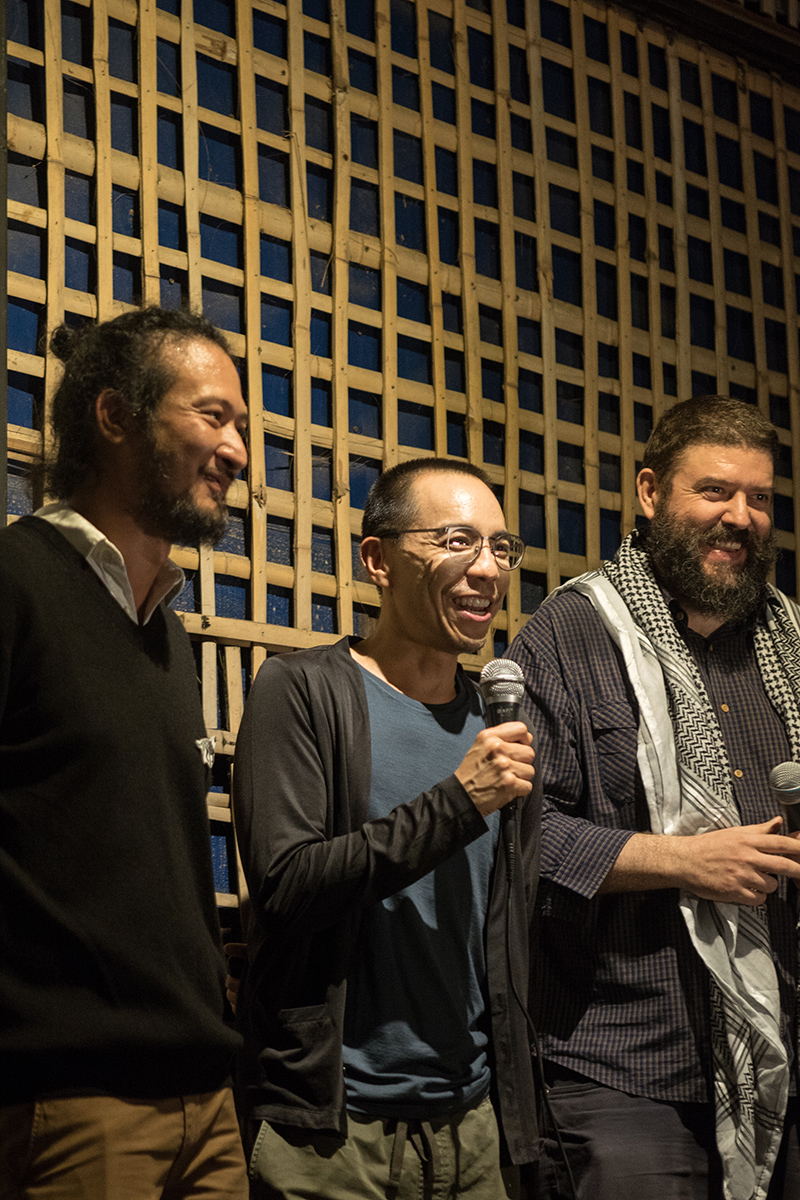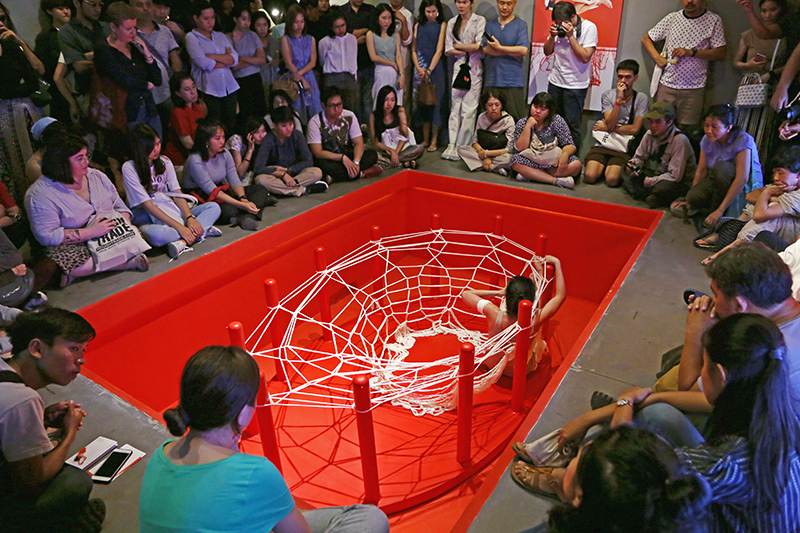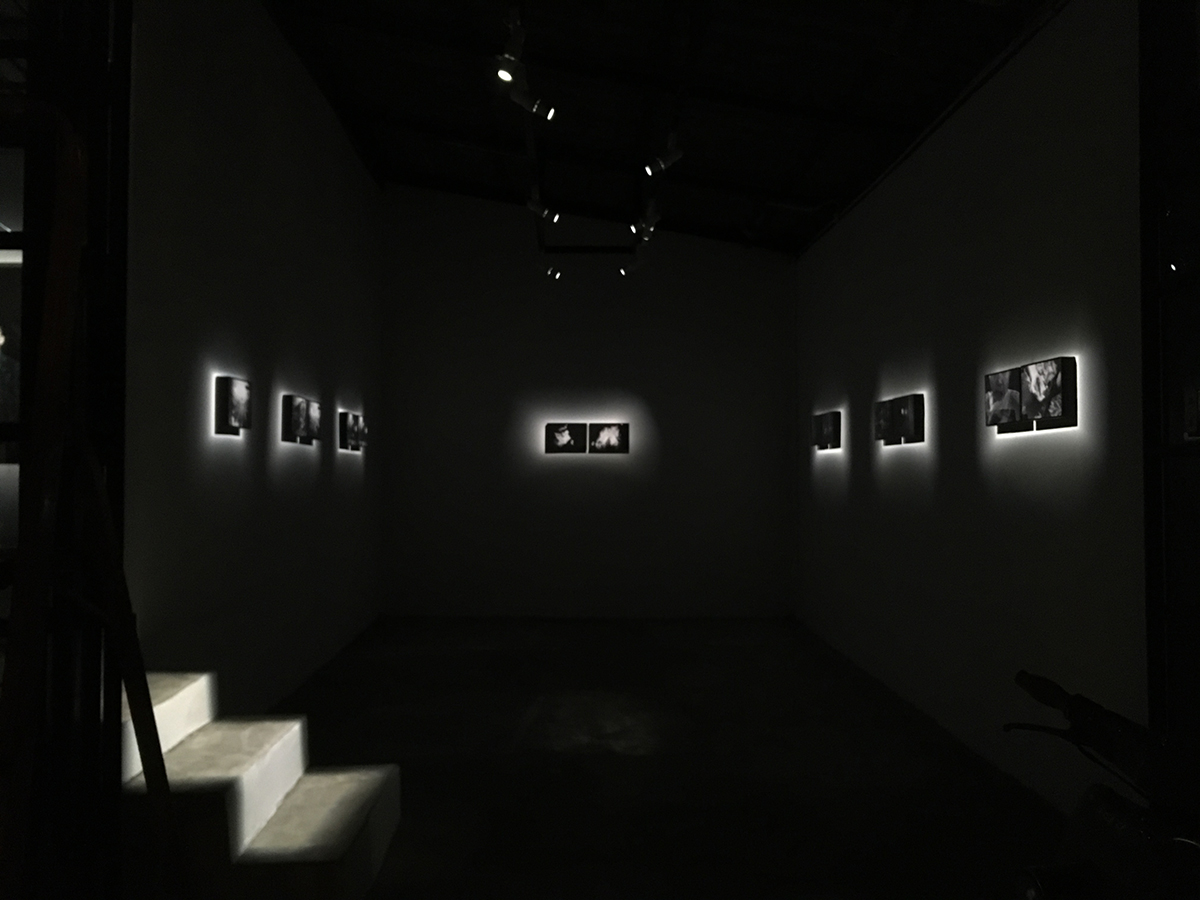Gallery Seescape curator Sébastien Tayac says he and gallery founder Torlarp Larpjaroensook fuel their endeavour with their differences as much as their similarities.
Since my arrival in 2003 in Chiang Mai, I have seen many galleries open and close after a year. Seescape nearly did not escape this trend. It almost closed three or four times, every time with the feeling that the next exhibition would be the last. The relative financial autonomy of Gallery Seescape was later possible thanks to Besto Boy, another creation of Torlarp Larpjaroensook.

Installation of the artworks for the exhibition “Plab Plab 10 year anniversary Gallery Seescape” from December 13th 2018 to February 13th 2019. (Tayac Sébastien and Torlarp Larpjaroensook)
How do you describe yourself in the context of challenging people’s perspectives via your work?
In 2003, I arrived in Thailand and met Torlarp Larpjaroensook in 2006. Gallery Seescape was created in 2008 in Chiang Mai by Torlarp Larpjaroensook as a place where different types of artists can have an opportunity to exhibit, and also where various actors of the art community can meet and exchange ideas. Larpjaroensook is a fervent admirer of Anselm Kiefer and Damián Ortega, and he became aware of the lack of art spaces, specifically those not devoted to neo-traditional art. I helped him from the beginning and as a result he asked me to join the Seescape adventure, as we share many art-related interests. I officially became the curator of the gallery in 2013, the year that I also started to work as a lecturer at the Faculty of Fine Arts, Chiang Mai University.
What does your role at Gallery Seescape involve? How do you balance the contradicting elements of your work?
I will not go into a list of what I do at the gallery or what a curator is supposed to do. It seems more interesting to me to see how it all works at the gallery. Although Torlarp and I are almost the same age, our various differences like being Thai and French, artist and art historian, founderand lecturer and so forth fuel the curatorial practice of the gallery.
Without falling into a practitioner-theorist stereotype, it is obvious that our academic and professional backgrounds orient our task at the gallery. Logically as a curator I have tasks that I perform alone, but we talk and share nearly all the steps while organising an exhibition – from the selection of the artist to the opening.
Since 2013, I have, among other things, established two things, a curatorial statement and an artist talk on the day of the opening of an exhibition. That’s not about giving an authoritarian interpretation or meaning of the exhibition and the artworks, but rather to place the viewer in a position where she or he questions.

Artist Talk during the inauguration of the exhibition “Almost Fiction” the 21st of December 2019. (Torlarp Larpjaroensook, Apichatpong Weerasethakul and Tayac Sébastien)
Tell us about your curatorial philosophy. How does it all come together?
My curatorial philosophy? I can easily say that’s really pragmatic. As a curator and a foreigner, you need to be aware of the social and political context of Thailand. Gallery Seescape, located in a very touristy area in Chiang Mai, in northern Thailand, has changed a lot in the last ten years. I believe that since 2013, my curatorial philosophy has evolved with the city.
In the early days of the gallery we sought to always to give the opportunity to a majority of artists, young or with experience. But I feel that now we also have the aim of attracting well known artists to exhibit in Chiang Mai. Chiang Mai is in the state of becoming an important city for contemporary art away from Bangkok. Many artists are now living in Chiang Mai, and collectors also want to show their own collections, like DC Collection, MAIIAM, and Zimmermann Collection.
What is also interesting is that the exhibited works allow us to reinvent the gallery, exhibition after exhibition. For example, we removed the floor for the performance of Kawita Vatanajyankur or even opened a door in the wall of the gallery between the two rooms of the gallery for Apichatpong Weerasethakul.
Regarding my writings, they are not simple descriptions, but on the contrary short multidisciplinary texts combining philosophy, art history, sociology, music or films, with popular or academic references, that function as an attempt to build links between all these fields in the mind of the viewer.
How do you strike a balance between the commercial and the creative? Do you handle the commercials yourself or is it outsourced to agents?
It has been said that there are no good galleries in Chiang Mai, which contributes to the absence of collectors. But should the reasoning not be inverted? The commercial aspect of a gallery is an important factor, but in the case of the Gallery Seescape, the first few years featured exhibitions without buyers. Since my arrival in 2003 in Chiang Mai, I saw many galleries open and close after a year. Seescape nearly did not escape this trend. It almost closed three or four times, every time with the feeling that the next exhibition would be the last. As I said before, it was not an easy situation for Seescape. At that time, it was also a question of not falling into the capitalist trap, even if the works are sometimes everyday objects, one does not sell works like other objects. The relative financial autonomy of Gallery Seescape was later possible thanks to Besto Boy, another creation of Torlarp Larpjaroensook. Besto Boy is both a functional sculpture and a simple lamp created in 2009, with sizes that varied from 30 cm to 215 cm. Besto is a true descendant of Pop art in the way it breaks down the barriers between high and low art. Even though Torlarp already insisted in the past on the importance of the connection between the function of an artwork and its form almost in a purely decorative way, particularly when recycling obsolete objects, with Besto, he has created a character which is both emblematic and hard to categorise.
When you talk about balance, I believe that because Torlarp and I have known each from a long time it brings equilibrium and the gallery thrives on it. It is a privileged situation to work like this, as a kind of collaboration. Sometimes we don’t even need to talk, as we know what each of us is thinking, even though it may be an opposing idea.

Gallery Seescape during the exhibition of Kawita Vatanajyankur “Unveil Escape” from August 3rd 2019 to September 18th 2019. Picture by Pornthep Chitpong.
How does your interaction with an artist evolve?
Since the opening of Gallery Seescape, we have organised hundreds of exhibitions and events. Anyone who has come to exhibit at Gallery Seescape remembers one thing: even if the gallery is no longer an alternative space, human relationships and discussions about artworks remain a priority. Some artists already know what they want from us, how to present and install their work, while others rely more on us, expecting us to build the exhibition around a theme and create a particular atmosphere that fits. Some artists are always with us during the installation, while others let us manage everything.
Written texts are also a way of bringing me closer to artists, of understanding what they want. And at the same time I must take a step back in order to know how to perceive the unsaid, because the aim of the latter is not to explain an artworks or the exhibition but give clues to understand the works on display.
Let’s talk about your long-term vision. Would it be safe to say that Gallery Seescape is a step towards manifesting this vision?
This is the eleventh year that the gallery continues to offer exhibitions every two months. Neither Torlarp nor I knew exactly how long this adventure would last. We are not a large gallery with great financial means and a huge staff. We do a lot of things by ourselves, but an important thing in our eyes is to continue keeping the link with education, both for students and young artists. Seescape must remain a place for discussion and learning, for artists of diverse backgrounds to exhibit. Because of my academic background as an art historian and professor, I mostly approach Gallery Seescape from a pedagogical point of view.

Gallery Seescape during the exhibition of Kawita Vatanajyankur “Unveil Escape” from August 3rd 2019 to September 18th 2019. Picture by Pornthep Chitpong.
Let’s get imaginative. What is there a crying need for? What kind of a service or product would elevate the art industry?
I will not speak on an international, national, or even a local scale. Chiang Mai, just as the rest of Thailand, needs to be able to continue to develop its artistic and cultural scene with more galleries, museums, and cultural centres, with public and private support. Unfortunately, it lacks a large community of curators, art critics and art historians. So, it is a bit difficult to see these spaces flourish.
Which shows, performances and experiences have shaped your own creative process? Who are your maestros? Whose journey would you want to read about?
Even if I was too young at the time, I consider the exhibition Magiciens de la Terre curated by Jean-Hubert Martin at the Centre Georges Pompidou and the Grande halle de la Villette in 1989 as something special in my way of thinking as a lecturer and as a curator. I could also talk about other exhibitions like Cities on the Move or even books The Global Contemporary and the Rise of New Art Worlds or even all the various writings of James Elkins. To all these references from the art world, I would also be tempted to add The Dialogue in Hell between Machiavelli and Montesquieu of Maurice Joly, Steppenwolf from Hermann Hesse, Mutual Aid: A Factor of Evolution of Peter Kropotkin, and a last one, All Gall Is Divided by Emil Cioran. As you can easily see, literature and politics occupy a large place in my writings and teachings.

Exhibition “AlmostFiction” by Apichatpong Weerasethakul, from December 21st toMarch 21st 2019
Tell us about your own personal evolution vis-a-vis the work that you do. What have you observed in the changing cultural landscape?
It is a privilege to be able to meet so many artists, curators and collectors, and to be both a faculty member at CMU and a curator at Seescape. My relationships with students or my colleagues, a more institutional art world as well as with professional artists integrated into the art world, makes me understand the differences that exists between these worlds, which sometimes can seem so close and sometimes so far.
Email: galleryseescape@gmail.com/ sebastientayac@yahoo.fr
Before you go – you might like to browse the Asian Curator curatorial archives . Contemporary art curators and international gallerists define their curatorial policies and share stories and insights about the inner runnings of the contemporary art world.











Add Comment